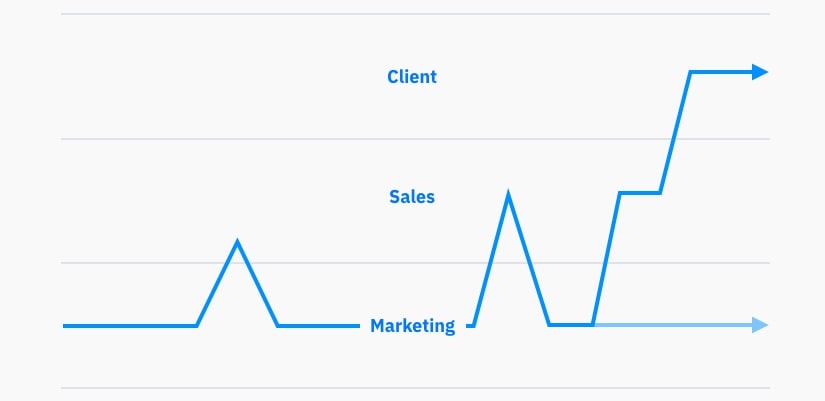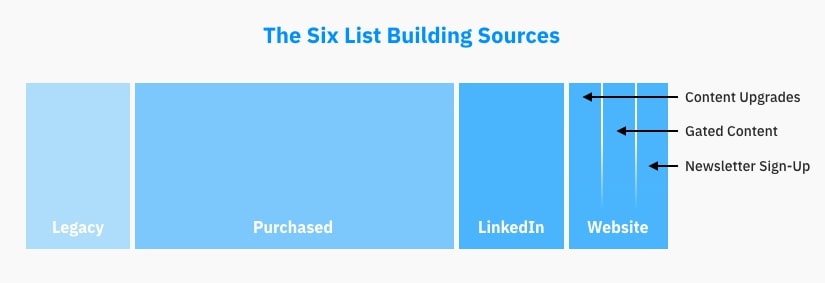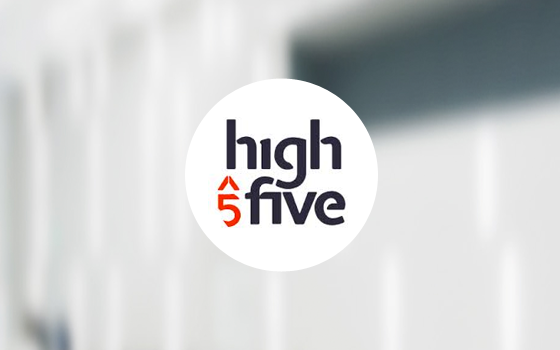“Everyone is buying, the only variable is time.”
Blair Enns
Like so many things Blair says, this is an extreme statement that’s intentionally designed to stretch your understanding of what is possible for your firm. Will ALL your prospects eventually hire you? Probably not. However, far more prospects could become clients than you realize. Your ability to turn prospects into clients is dictated by how effectively you create and maintain relationships. That’s it.
To be an effective marketer, you should assume that your prospects are short-sighted and impulsive. They are very much living in the now, and they have to make quick, effective decisions that will best serve their organization. They are busy, and they have many people wanting things from them both inside and outside of the firm. They are under a great deal of pressure to perform, and they only have enough time and energy to focus on the things that will help to ensure their professional survival — today, this week, this quarter. They are forever locked in the middle of a ‘what have you done for me lately’ mentality. The people they serve indirectly ask this question of them, and they in turn ask the same of the people serving them. They need an important problem solved now, and the way they choose to solve that problem will most likely have something to do with what they have been recently exposed to. While some of your prospects may have long memories, it’s a better strategy to assume most of them don’t.
If your firm is top of mind when a need arises, the chances that prospects will at least get in touch with you are highly favorable. Once they get in touch with you, your marketing has performed its function, for now. All interactions from that point forward are sales activities until the prospect does one of two things: They will either become a client, or you will return them back to the marketing stage. Those are the only two options.
Not forever, just for now
You being awarded your prospect’s business is never lost, only delayed. Many firms consider the lead dead after they get a chance to win their business and don’t. Losing the bid is not the end; it’s just another step on the prospect’s journey to eventually hiring you.
That is not a consolation designed to make you feel better. It is the truth, or at least it can be if you believe and behave like it is. If you operate with this long-game mentality from the start of your interactions with your prospective client, you’ll have a much easier job maintaining the dignity, poise, and non-attachment that is so critical in your sales interactions. If either party decides now isn’t the right time for the two organizations to work together, that’s OK. The long-term health of the relationship is much more important than winning today.
It doesn’t always feel that way, though, does it? Once you want the win, sometimes you want it badly. Maybe you even need it. If you lose, you might take it personally. Maybe you’re a little disappointed in yourself and a little mad at them. Our prospects aren’t the only ones who are prone to sometimes being short-sighted and impulsive, are they?
Your best is good enough
There’s a very real ‘the rich get richer’ dynamic here. Non-attachment is so much easier when you don’t need the win. The less you need it, the less needy you’ll act, the more confidence the prospect perceives, the greater the chance the prospect turns into a client. Your sales-stage neediness is dictated by how effectively you create and maintain relationships through your marketing.
You can’t afford to take losses personally. You can’t get overly attached. You have to rest in the knowledge that you’ve done your part and if the timing wasn’t right, it wasn’t. Eventually, it will be.
But you can only rest in the knowledge that you’ve done your part if you really believe you have. What does doing your part even mean? How much effort is enough? When it comes to business development, there are only two ways in which you can apply effort — effectively and efficiently build relationships with right-fit prospects (marketing) and bring the right ones on as clients at the right time (sales).
In your pre-client relationship with them, your prospects will spend the majority of their time in the marketing stage and occasionally move into the sales stage (perhaps a number of times) on their way to ultimately turning into a client.

So, you spend most of your time ‘doing your part’ on the marketing side of things, and you’re dealing with short-sighted and impulsive people. Your knowledge is the currency with which you purchase small amounts of your prospect’s attention through your marketing journey with them. If your prospect is regularly (a few times a month, forevermore) hearing from you in an educational, empathetic way, you are doing your part — for that prospect. The thing, of course, is that you need more than one prospect. The more prospects you’re serving through your relevant education, the more you’ll have rise into the sales stage, the more you’ll win, and the less needy you’ll be.
Grasping the idea that you need to have a lot of prospects paying attention to you is pretty easy. Accumulating a sufficient number of prospects? Not so much.
Building an audience isn’t what it used to be
First we need to agree on what the right number of prospects is. For most firms in the creative and digital space in North America, the answer is somewhere between 2,000 and 10,000 depending on your target market. The average firm in this space has a functional prospect list of under 1,000, so most firms are facing the need to at least double their list. This isn’t as easy as it used to be. In fact, it’s incredibly hard, and has to be done consistently and carefully.
An important point to mention here is that the rules change as your firm becomes a more powerful marketing entity. If you have 15,000 adoring fans on your marketing list, are a highly coveted keynote speaker at home and abroad, and have far more opportunity than capacity year over year, you’re playing a different game than most other firms out there, and the rules are different for you.
The majority of firms don’t fall into that category, though, and for them building an audience is a tall order. As recently as a few years ago, you could just buy a list of emails in your target market and start emailing them — all of them — at once. Email purchasing has been a sensitive topic for as long as it has existed, but doing it effectively (and legally) has gotten more and more complex over time. For many firms, purchasing a list is still a critical element of their marketing strategy, but it’s not enough on its own for any firm. Now more than ever, building an email list is something that is earned, in addition to being bought. If you’re going to earn those emails, you have to have a way of getting them. For most firms, the most effective and efficient way of doing this is through your website.
The six list building sources
There are six techniques or sources you will use to amass your list. Although the percentages will vary, sometimes significantly, from firm to firm, most firms will see their prospects surface and convert through these categories and estimated proportions.

Your legacy list
This is the easiest and most obvious source, so we’ll deal with it first. Your legacy list is great because it’s already warm. Unless you’ve been completely ignoring the email list and sending nothing for the past handful of quarters or years, these people won’t be shocked to get an email from you. There are two factors that significantly cull legacy lists though: entropy and evolution.
You’ve probably been building your list for a long time, and it has become less tidy with each passing quarter. There are likely a large number of emails on that list that are no longer valid. You need to clean all of those out, and that’s going to reduce the list size significantly in most cases.
Your firm has also changed quite a bit over time. If you’re getting serious about the next stage of your firm’s marketing, it’s likely you’re going to define your target audience more specifically. After taking out the prospects in the list that’s already been decimated by the aforementioned cleanse, you’re going to have to do another pass to take out those who no longer match your ‘right fit client’ definition.
After accounting for your legacy list’s entropy and your firm’s evolution, your list will probably have shrunk by half. Many firms start this process with between 500 and 1,000 and wind up with 250-500. That’s OK, though, hundreds of prospects are far better than tens! And this is just the beginning of your list building process.
List purchasing
For most specialized firms in the US that serve a US market, list purchasing is alive and well, at least for now. But as previously noted, it’s not what it used to be. Today, when you buy a cold list, you need to slowly add those names into the program. Say, for example, you purchase 2,000 names and after you run a professional list cleanse (which is highly recommended for reasons that are beyond the scope of this article) you have 1,500 left. A 25% trash rate on a brand new, ‘verified’ list from a reputable list provider is so typical it should be expected. So, you’ve got 1,500 new prospects to start nurturing. Let’s get started!
Not so fast. If you send to all of those brand new prospects at once, you’re not going to get a very high engagement rate because they’ve never gotten anything from you and in many cases won’t even know who you are. In order to preserve your sender reputation, which is the single most important factor you need to consider when it comes to email marketing, you need to make sure your emails are getting a certain level of engagement. Because of this, you can only send to a small percentage of those brand new names per email blast. When we work with our clients, we carefully plot out the mixture of unaware vs. aware prospects we’re emailing on each individual blast. It’s actually that important. In this example, it could easily take 6-12 months to get that list of 1,500 fully engaged. That’s OK though. You understand the nature of marketing, and you’re playing the long game.
As marketing gets more difficult and requires more patience and perseverance, there are fewer firms that are able to do it well, so the field naturally thins itself in your favor.
LinkedIn ads
Because email is more difficult than it used to be, you need another way to get in front of your prospects. For most expert firms, the best way to do this is LinkedIn. Their investment to return in the B2B space is typically tops, and they allow you to use crafty and helpful techniques to carefully target your audience. Over the course of a year of smart but thrifty LinkedIn spending with ads directed toward highly engageable content on your website, most firms can expect to add hundreds more prospects to the email list.
Your website, in three ways
For most firms, website conversions (form submissions) are the second largest source of new prospects, especially when you consider that the prospects that come from the LinkedIn ads only actually get on your email list if they convert on the website asset the LinkedIn ad directed them to.
The three most typical conversion points are the traditional newsletter signup, gated content, and content upgrades. The first is understood by all, but the latter two are worth digging into a bit.
Everyone is familiar with gated content, right? We’re typically talking about webinars and whitepapers that you have to fill out a form to access. In years past, this was a firm’s primary on-site conversion tool, but we’ve seen content upgrades challenge that recently.
The problem with gated content is that it’s gated.
But really. Because it’s gated, Google can’t index it, so there’s virtually no SEO value of this page. This is a particular problem when it comes to whitepapers, which are typically thousands of words in length. That’s a lot of expert content you’re not allowing Google to read in an effort to send interested prospects your way. The second problem is that since it’s gated, the prospect has to be pretty confident the juice is worth the squeeze. If they don’t know the firm well, and only have a few hundred words to pique their interest, they may very well decide it’s not.
Content upgrades solve all of this. Picture that same whitepaper, maybe 2,000 words of content but with no form blocking access to it. Google indexes it; your prospects read or scan as much as they want. That all sounds great, except there’s no conversion point, and we need the conversion to get the email. The content upgrade is something relevant embedded in the article that prospects have the option to access through a form. This should be something that’s a helpful takeaway. Maybe it’s a spreadsheet calculator they can download, a well designed chart that maps out a process you’re describing in the article, or a helpful printable checklist. It could be anything, as long as it’s relevant and valuable. One way that Chris Butler describes the difference between what is in the article and what is in the upgrade is “that the article freely shares the idea, concept, strategy, or tactical plan, while the upgrade gives prospects a tool to help apply that thinking to their specific situation or take action on the article’s recommendation. The article is the education, the upgrade is the tool.”
Between these three conversion avenues, a firm can expect to generate hundreds more prospects per year. That adds up quite a bit over time.
APV is the new ABC
Now, all marketing is a long game, and any time you play the short game, you lose — sometimes for good. A prospect who decides to not hire you today but still respects and values your intelligence is still a prospect. A prospect whose time you’ve wasted is truly a lost lead, and you’ll likely never turn that prospect into a client. If you bait and switch your prospects with excessive forms that don’t exponentially deliver on the effort they exert to fill them out, they’ll likely never fill out another one or, worse, take you seriously moving forward.
So, Always Provide Value. If you do that in the marketing stage, you won’t have to be so preoccupied with an Always Be Closing mentality. Is that still a thing?
Play your game, not theirs
The larger and more engaged your email list is, the more freedom you have to give more content away and gate less content. The challenge so many firms face is that they see the firms and individuals they look up to behaving in one way, and they assume that they should do the same because that’s how the successful ones do it. In almost every case, the successful ones are only able to operate as they do because they are successful. Once upon a time, they too had to figure out how to amass their list and build their marketing machine. But things change pretty rapidly these days, and the techniques they employed to grow into prominence five, 10, 15, or 20 years ago most likely won’t work for you today.
The benefit we have as highly focused experts is the same benefit your firm has as highly focused experts: We have a front-row seat for the combined reality of our clients day-to-day experiences, successes, and struggles, which enables us to accurately see the present and predict the future of which techniques and strategies help firms most effectively turn prospects into clients.
Because of the proof our clients’ data sets provided us, we knew five years ago that email marketing was far more effective than the inbound-only prophets were saying it was. Because of the same proof, we saw a few years ago that the trend was starting to change, which allowed us to start employing different email strategies, additional outbound techniques, and on-site techniques to build email lists in a more nuanced, effective way. Today, we’re able to custom-tailor a broad combination of tools in order to generate the desired results for our clients.
The landscape has never been more subtle, more complicated, and more customized to each individual firm. This will most likely always be true.
What has also always been true, to date, is that if you do your job of being an active, helpful, deeply insightful voice in your prospect’s ear, there’s a strong possibility that prospect will, one day, be a client. It’s only a matter of time.



